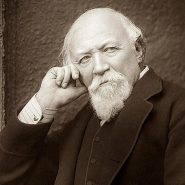By John Donne
Mark but this flea, and mark in this,
How little that which thou deny’st me is;
It sucked me first, and now sucks thee,
And in this flea our two bloods mingled be;
Thou know’st that this cannot be said
A sin, nor shame, nor loss of maidenhead,
Yet this enjoys before it woo,
And pampered swells with one blood made of two;
And this, alas, is more than we would do.
Oh stay, three lives in one flea spare,
Where we almost, yea, more than married are.
This flea is you and I, and this
Our marriage bed, and marriage temple is;
Though parents grudge, and you, we’re met,
And cloistered in these living walls of jet.
Though use make you apt to kill me,
Let not to that self-murder added be,
And sacrilege, three sins in killing three.
Cruel and sudden, hast thou since
Purpled thy nail in blood of innocence?
Wherein could this flea guilty be,
Except in that drop which it sucked from thee?
Yet thou triumph’st, and say’st that thou
Find’st not thyself nor me the weaker now;
’Tis true; then learn how false fears be:
Just so much honor, when thou yield’st to me,
Will waste, as this flea’s death took life from thee.
Originally published posthumously in Songs and Sonnets (1633) by John Donne. Public domain.
Analysis
John Donne’s “The Flea” exemplifies the metaphysical conceit — a bold, elaborate metaphor that transforms a trivial object into the center of a profound argument.
Here, Donne’s speaker uses the image of a flea that has bitten both him and his beloved as a vehicle for seduction, arguing that their mingled blood within the insect already unites them more intimately than physical love ever could.
The Flea as Metaphor for Union
Donne’s conceit is at once playful and provocative. The flea, a common pest, becomes a symbol of sacred union — “our marriage bed, and marriage temple.” Through this extended metaphor, the poet collapses distinctions between the physical and the spiritual, the sacred and the profane.
The argument unfolds as witty persuasion: if the mingling of blood within a flea is innocent, why should physical union be deemed sinful or shameful?
Tone, Irony, and Argument
The poem moves through three stanzas that mirror the stages of the seduction argument:
- The proposition — the flea as a symbol of shared intimacy.
- The complication — the woman threatens to kill the flea, and the speaker pleads for its life.
- The resolution — she kills it, and he turns her act into the final proof of his point.
The speaker’s tone shifts from mock-earnest reasoning to ironic triumph, showcasing Donne’s characteristic blend of intellectual agility and emotional daring.
Religious Imagery and Paradox
Donne’s choice of language — “marriage temple,” “sacrilege,” “three lives in one flea” — parodies religious discourse to heighten the irony.
By invoking sacred imagery to justify physical desire, Donne exposes the tension between body and soul, sin and sanctity. His argument is not purely carnal; it dramatizes the metaphysical struggle to reconcile sensual love with spiritual meaning.
The Metaphysical Poetic Style
“The Flea” is written in rhymed couplets with a conversational rhythm, alternating between reason and whimsy. Donne’s control of voice is masterful: the speaker’s clever reasoning borders on absurdity, yet his intellect makes it compelling.
The poem’s humor and audacity reveal Donne’s signature trait — using logic and wit to challenge moral convention.
Themes of Desire, Persuasion, and Rationalization
At its heart, the poem explores how desire manipulates reason. The speaker constructs a rational case for passion, only to have it undercut by the woman’s decisive act — crushing the flea. Yet even this defeat becomes a rhetorical victory, as he turns her gesture into proof that yielding to him would cost no more than killing the insect. Donne thus transforms a comic episode into a meditation on the power of language, persuasion, and paradox.
